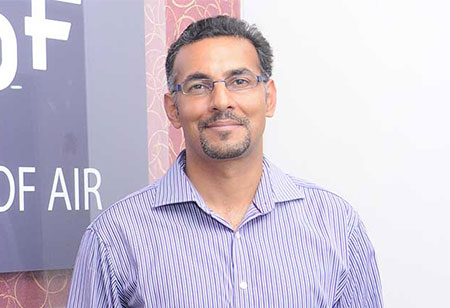Cities consume nearly 75 percent of global energy resources and account for 80 percent of the emissions. By 2050, it is anticipated that 66 percent of the world’s population will be living in cities. In addition to these, cities are also faced with new challenges such as severe budget constraints, high occupant expectation and the need to attract jobs and investment. To be more efficient, sustainable, livable, and attractive, cities need to become smarter.
Up until now, the conversation around smart cities has been focused on technology and its impact on infrastructure, i.e. the use of technology such as big data and ICT to better manage urban assets such as public transit, parking meters, utilities and so forth. But it's time to change the conversation! A truly smart city, in my opinion, focuses on its occupants and aims to achieve three goals - to improve the quality of life, economic competitiveness, and sustainability.
Smart buildings go a long way in achieving all these goals, and more. Smart buildings help better manage and monitor assets, reduce energy costs and carbon footprints, and shape the world around us. Controlled air temperature, personalized lighting, remote security, and stream¬lined processes are all within reach with smart building technology.
Why make buildings smart?
Leveraging cutting-edge technologies, such as the IoT(Internet of Things), M2M, Edge Computing and intelligent data analytics, smart buildings can enhance the Occupants' Experience (OE)and create more attractive, desirable places to work. The experience of the building users can be personalized to their individual preferences, while real-time data and predictive analytics work together to optimize his/her workspace all year round. It can also track and improve occupant health, performance, and productivity which is imperative for any business considering employees are the biggest asset of any growing company.
At the same time, in a smart building, the Building Intelligence System helps sustain optimal levels of performance, thereby making them highly efficient and improving the Operational Efficiency (OE) of the building. New sensors and controls have succeeded in creating dynamic, grid-integrated buildings which are now operating at minimal energy consumption levels.
Smart buildings respond to real-time operating conditions - whether that means automatically turning off the lights when a conference room is empty, lowering the thermostat when the temperature outside rises, or even diagnosing a system malfunction and rectifying it immediately to enable buildings to operate at peak efficiency.
Smart buildings make cities smarter
Smart Buildings are flexible enough to adapt to the ever-changing occupant needs, intelligent enough to factor in external & internal conditions, proactive in course-correcting to bring efficiencies and at the same time, are highly efficient to meet the energy-saving targets. The promise of smart buildings is incredible-made possible by robust, reliable technology.
-
Smart buildings help better manage and monitor assets, reduce energy costs and carbon footprints, and shape the world around us. Controlled air temperature, personalized lighting, remote security, and stream¬lined processes are all within reach with smart building technology.
Gaurav Burman, VP & Country President, 75F India
Here are the top four trends in Smart Buildings, brought on by the integration of technology, that makes Smart Buildings integral to the development of smart cities.
First, interoperability is becoming the new normal in Smart Buildings
Thanks to IoT simple, ubiquitous connectivity of all devices in the building is possible. The myriad devices and systems in a building function in harmony, whereas big data analytics and cloud computing, enable these devices to predict, monitor, course-correct and control the behavior of the building. New connections are happening, not just between devices in a system, but among systems in a building and buildings in a portfolio. The avalanche of data coming in from buildings is being converted into useful, actionable information with the help of smart algorithms and big data analytics.
Second, the information loop - from the grid to plug
The ability to get truly granular is now possible with Smart Buildings. Deployment of IoT, makes operations in a building visible and transparent – from the performance of the grid where energy losses are usually high to the end application, even determining how and where energy can be saved. Facility managers are able to visualize better what’s happening across their footprint and make educated decisions to correct and improve conditions.
Today’s Smart grids allow energy distribution to be managed in real-time based on immediate data rather than historical patterns of power usage as was done earlier. Together with smart meters, it could noticeably reduce a business’s energy costs and improve their sustainability credentials.
Third, building management goes mobile
An integrated system where devices are in constant conversation with each other means simplicity, flexibility, and improved control. While mobile apps that provide ‘monitoring alerts’ for individual devices in the buildings have been around for a few years, IoT takes it to the next level. A facility manager can now not only monitor and manage various devices in a single view but can control them all from his mobile.
Fourth, Buildings are becoming more people-centric
Smart buildings enable flexible, adaptable, and efficiently managed spaces. The demands and comforts of the occupants become the prime focus thereby improving occupant well-being and productivity. In fact, a study by Sodexo estimates that the impact of a comfortable indoor environment on employee productivity is as high as 15 percent as it affects employee health, cognitive abilities, problem-solving capabilities, concentration, and ability to innovate.
Smart buildings hold profound potential, and there is no denying that technology like IoT and edge computing are breathing new life into buildings, whether new or old. The impact of buildings on the everyday lives of people is being redefined. They are no longer mere physical structures but are slowly starting to define the quality of life of the citizens and the entire city.
